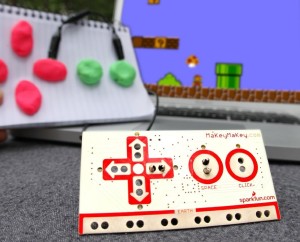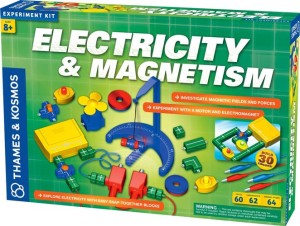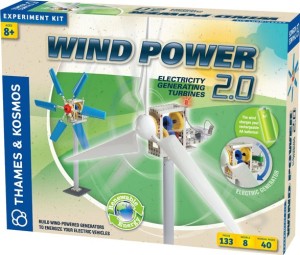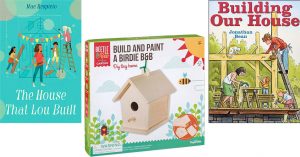By Katherine Handcock, A Mighty Girl Communications Specialist
 For kids who love to find out how things work: from electricity to computers to alternative energy sources, their curiosity knows no bounds. While it can seem challenging to work engineering, technology, or math into play, the truth is that there are lots of great toys available that give kids the chance to learn about engineering and technology -- all while having a great time!
For kids who love to find out how things work: from electricity to computers to alternative energy sources, their curiosity knows no bounds. While it can seem challenging to work engineering, technology, or math into play, the truth is that there are lots of great toys available that give kids the chance to learn about engineering and technology -- all while having a great time!
Whether you have a budding engineer on your holiday list or you just want your Mighty Girl to feel comfortable with technology, the 25 engineering, technology, and math toys featured here will no doubt encourage her interest in learning more! It’s the perfect way to encourage kids to explore these subjects in fun, creative ways.
For our top picks of basic building toys, including more options for young children, check out our previous blog post, Putting It All Together: Top 20 Building Toys for Mighty Girls.
For more toys for young engineers and scientists, check out the STEM section of our 2014 Holiday Gift Guide or A Mighty Girl's entire selection of Science / Math Toys.
To learn about more of our favorite toys of all varieties for Mighty Girls, check out our Girl Empowerment Toy Blog Series or visit our 2014 Holiday Guide.
Gifts That Count: Math Toys
![51mr2tkubhl[1]](https://www.amightygirl.com/wp/wp-content/uploads/2014/12/51mr2tkubhl1-300x300.jpg) Before you can get into technology and engineering, you need a strong foundation in math! Math toys are a great way to teach fundamentals while also reminding kids that math is fun — that playing with numbers is a way to help understand our world. This selection of math toys is sure to spark the number-lover in your child.
Before you can get into technology and engineering, you need a strong foundation in math! Math toys are a great way to teach fundamentals while also reminding kids that math is fun — that playing with numbers is a way to help understand our world. This selection of math toys is sure to spark the number-lover in your child.
One of the first steps in math is counting from one to ten. With the Counting Cookies from Learning Resources (age 2 - 5), kids can experiment with ten cookies, each with a number on the bottom and the corresponding number of chips on top. The included plastic jar can be used for storage, or for playing simple math games — putting the numbers in sequentially, or sorting out odd numbers, for example. And since the cookies can be used as play food props as well, it’s a great way to incorporate math into pretend play.
Estimating lengths is a very handy skill; to start building it early, check out the Inchimals from Fat Brain (age 3 - 7). These lovely wooden blocks range in size from the 1” ladybug to the towering 12” giraffe. The included dry erase booklet features a wide variety of math puzzles that introduce counting, number value and recognition, scale, and more. It’s a playful way for animal-lovers to experiment with number concepts!
![51mrocsulbl_1_[1]](https://www.amightygirl.com/wp/wp-content/uploads/2014/12/51mrocsulbl_1_1-300x280.jpg) Learning Resources’ Super Sorting Pie (age 3 - 7) is a great way to teach the basics of counting and categorizing, skills that are critical to developing math fluency. Three double-sided sorting cards encourage kids to sort the multi-colored fruit fillings in different ways. For an added benefit, the jumbo tweezers help develop fine-motor and pre-writing skills.
Learning Resources’ Super Sorting Pie (age 3 - 7) is a great way to teach the basics of counting and categorizing, skills that are critical to developing math fluency. Three double-sided sorting cards encourage kids to sort the multi-colored fruit fillings in different ways. For an added benefit, the jumbo tweezers help develop fine-motor and pre-writing skills.
Young children will have a ball playing with Uncle Goose’s Groovies Math and Patterning Blocks (age 2 and up)! This set of 28 grooved blocks features debossed numbers, as well as mathematical symbols and geometric shapes. The grooves aren’t just decorative: kids can interlock the blocks to form equations, patterns, and larger shapes. Meanwhile, parents will love that these blocks are made of renewable Michigan basswood and finished with eco-friendly inks.
An abacus is a great toy, but it’s also a sophisticated counting and mathematics tool! Melissa and Doug’s Deluxe Wooden Abacus (age 3 - 6) lets young kids start experimenting with counting, pattern, and colors, while older kids can start learning to visualize simple addition and subtraction and learn about concepts like counting by 10s.
![109204dd[1]](https://www.amightygirl.com/wp/wp-content/uploads/2014/12/109204dd1-293x300.jpg) Older kids can start exploring geometry with the K’Nex Education Simple Math and Geometry kit (age 7 and up). The 142 pieces in this kit allow kids to build a variety of different flat and 3-dimensional shapes, teaching concepts like symmetry, congruency, angles, fractions, and more. This set is excellent for classroom use in teams of three or four, but it can also be a great tool for kids to play with at home.
Older kids can start exploring geometry with the K’Nex Education Simple Math and Geometry kit (age 7 and up). The 142 pieces in this kit allow kids to build a variety of different flat and 3-dimensional shapes, teaching concepts like symmetry, congruency, angles, fractions, and more. This set is excellent for classroom use in teams of three or four, but it can also be a great tool for kids to play with at home.
To challenge your mental math skills, check out 24 Game: Double Digits (age 7 - 12)! 48 cards with three different challenge levels teach mental math and problem solving. Since it focuses on math concepts and procedures, it encourages an in-depth understanding, rather than just memorizing. And since this version goes into double digit numbers, it’s a great way to add additional challenge for math-lovers!
Programmed for Fun: Computer and Programming Toys
![robot-turtles-1_1[1]](https://www.amightygirl.com/wp/wp-content/uploads/2014/12/robot-turtles-1_11-293x300.jpg) Just like math, computers seem complicated but start out using simple rules that kids can learn early! Programming skills can be useful in a wide variety of careers and hobbies, so it’s helpful to get kids hands-on with programming concepts early. These toys encourage kids to tinker with both the hardware and software behind computers and learn how it all works — and how they can program it themselves.
Just like math, computers seem complicated but start out using simple rules that kids can learn early! Programming skills can be useful in a wide variety of careers and hobbies, so it’s helpful to get kids hands-on with programming concepts early. These toys encourage kids to tinker with both the hardware and software behind computers and learn how it all works — and how they can program it themselves.
For a quick way to tinker with input devices, check out MaKey MaKey (age 3 - 15). This simple kit allows plenty of creativity by allowing you to turn any object that conducts a small amount of electricity into a touch pad. Kids experimenting with MaKey MaKey have made piano keys out of bananas, drawn joysticks on a sheet of paper, and even turned alphabet soup into a keyboard for browsing the web! This fun device works with any computer; the only limit is your imagination!
Robot Turtles (age 4 - 7) made history on Kickstarter as the most backed board game ever! This game can be played by 2 to 5 players, with one player acting as the “turtle mover”, who carries out the other players’ instructions. Kids build a program for their robot turtle using cards inspired by the Logo computer language, and try to get past obstacles to reach their goal. By incorporating debugging, longer code strings, and functions, this game grows with kids as they perfect their skills.
![513k3n_2b3okl_1_[1]](https://www.amightygirl.com/wp/wp-content/uploads/2014/12/513k3n_2b3okl_1_1-300x300.jpg) If you’d like to explore the parts that make a computer work, the Raspberry Pi Ultimate Set (age 9 and up) allows you to build and program your own computer for under $100! Use the easy-to-install components to build your computer, then add Raspberry Pi’s New Out Of Box Software (NOOBS) to get working on your hand-made computer right away — or, you can design your own program to get your system going. The Raspberry Pi Ultimate Set includes components to assemble a CPU, plus a Raspberry Pi case, power supply, and other accessories to let you get the most out of your Raspberry Pi.
If you’d like to explore the parts that make a computer work, the Raspberry Pi Ultimate Set (age 9 and up) allows you to build and program your own computer for under $100! Use the easy-to-install components to build your computer, then add Raspberry Pi’s New Out Of Box Software (NOOBS) to get working on your hand-made computer right away — or, you can design your own program to get your system going. The Raspberry Pi Ultimate Set includes components to assemble a CPU, plus a Raspberry Pi case, power supply, and other accessories to let you get the most out of your Raspberry Pi.
For the ultimate in build-your-own fun, check out the Arduino Starter Kit (age 10 and up). Arduino is an open-source electronics platform that you can use to do just about anything. The Starter Kit gets you learning the tools of the trade, including how to assemble components, how to program, and how to make your computer system interact with the physical world with sensors and actuators. With dozens of additional components to work with and a thriving community of makers to learn from, Arduino is sure to prompt intriguing and creative projects from your kids!
Power Up Play: Electricity and Circuit-Themed Toys
 Of course, before you can have a computer, you have to power it! Whether you’re working on the conceptual ends as an engineer or architect, or getting hands-on as an electrician, you need to have a solid understanding of how electrical power works. These toys let kids explore electricity in fun, safe, and easy ways — no soldering required!
Of course, before you can have a computer, you have to power it! Whether you’re working on the conceptual ends as an engineer or architect, or getting hands-on as an electrician, you need to have a solid understanding of how electrical power works. These toys let kids explore electricity in fun, safe, and easy ways — no soldering required!
Ms. Frizzle and the kids from The Magic School Bus provided inspiration for curious kids on TV, and they’ve also inspired a line of science kits for kids. Magic School Bus: Jumping Into Electricity (age 5 - 10) provides a simple introduction to how electricity works and how it can affect the world around us. Create a small lightning bolt, build a light switch, learn about insulators and conductors, and more with this fun set.
Thames and Kosmos makes science kits with a wide variety of themes, and their Electricity and Magnetism kit (age 8 and up) provides a safe and intriguing look at how these properties work and how they relate to one another. Simple plug-and-socket connectors allow for easy assembly, while the unique shapes and bright colors of the pieces make it simple to follow the directions. Kids will build projects like a loudspeaker, an electromagnetic relay switch, and a telegraph key, all while learning fundamental principles.
![61l_2bay27obl_1_[1]](https://www.amightygirl.com/wp/wp-content/uploads/2014/12/61l_2bay27obl_1_1-300x227.jpg) For an expanded range of electronics to play with, Elenco’s Electronic Playground 130 (age 10 and up) offers 130 electronics projects, all built into a single board! Spring coil connectors allow kids to assemble the projects safely, but without the guided shaped pieces of the sets for younger electricians, this kit provides some added challenge for older kids. With intriguing projects like a logic circuit, and organ, or an AM broadcast station, this kit will give kids lots to explore.
For an expanded range of electronics to play with, Elenco’s Electronic Playground 130 (age 10 and up) offers 130 electronics projects, all built into a single board! Spring coil connectors allow kids to assemble the projects safely, but without the guided shaped pieces of the sets for younger electricians, this kit provides some added challenge for older kids. With intriguing projects like a logic circuit, and organ, or an AM broadcast station, this kit will give kids lots to explore.
For a series of fun, compatible kits that allow kids almost limitless exploration with electricity and electronics, check out the Snap Circuits line from Elenco for ages 8 and up. These collections of circuit components snap together for easy assembly, allowing kids to create a wide variety of electronics project, or to come up with their own designs. You can start out with the original Snap Circuits, which includes 305 do-it-yourself projects, and then add in additional specialized sets, like Snap Circuits Sound (sound and recording experiments), Snap Circuits Light (light-based experiments), or Snap Circuits Snaptricity (electricity and magnetism experiments). Snap Circuits also makes a few individual project kits, like the RC Rover which lets you build your own remote controlled vehicle, or the Flying Saucer, which lets you send a propeller flying through the air! With an almost never-ending selection of projects to work on, these kits are sure to capture your child’s attention.
![little-bits-2[1]](https://www.amightygirl.com/wp/wp-content/uploads/2014/12/little-bits-21-300x200.jpg) For even more complex electronic exploration, check out littleBits. This modular electronics line snaps together with magnets and can be used either for play or for prototyping designs quickly and easily — while we’ve classified it as a toy, many adults use littleBits as a tool! The littleBits Base Kit (age 10 and up) will get you started, with enough modular components to incorporate a variety of functions, including lights, sounds, and sensors. Since the kits are all compatible, you can then expand your collection with a general set, like the littleBits Deluxe Kit, or with specialized sets like the cloudBit Starter Kit, which allows you to connect your devices to the internet, and littleBits Synth, which lets you create sound machines like Keytars and spin tables. With new modules releasing all the time, the possibilities really are endless.
For even more complex electronic exploration, check out littleBits. This modular electronics line snaps together with magnets and can be used either for play or for prototyping designs quickly and easily — while we’ve classified it as a toy, many adults use littleBits as a tool! The littleBits Base Kit (age 10 and up) will get you started, with enough modular components to incorporate a variety of functions, including lights, sounds, and sensors. Since the kits are all compatible, you can then expand your collection with a general set, like the littleBits Deluxe Kit, or with specialized sets like the cloudBit Starter Kit, which allows you to connect your devices to the internet, and littleBits Synth, which lets you create sound machines like Keytars and spin tables. With new modules releasing all the time, the possibilities really are endless.
Engineering Fun: Engineering Toys and Kits
![51hkkfj9w-l_1_[1]](https://www.amightygirl.com/wp/wp-content/uploads/2014/12/51hkkfj9w-l_1_1-255x300.jpg) Most kids are fascinated when they discover that there's an engineer behind almost everything they see! From the simplest of machines to the most complex constructions, engineering is at the heart of our busy world. For kids who’d like to explore the world of engineering, these toys provide some great opportunities to have fun while solving engineering challenges — and building something that really works.
Most kids are fascinated when they discover that there's an engineer behind almost everything they see! From the simplest of machines to the most complex constructions, engineering is at the heart of our busy world. For kids who’d like to explore the world of engineering, these toys provide some great opportunities to have fun while solving engineering challenges — and building something that really works.
It’s amazing to realize that simple machines and structures, like levers, pulleys, and gears, are at the core of the complicated equipment we see all around us. K’Nex’s Education line (age 8 and up) has a series of kits designed to teach kids how these basic machines and structures work. Their Introduction to Simple Machines Kits cover Levers and Pulleys, Gears, and Wheels & Axles and Inclined Planes, each of which allow kids to build several models that demonstrate the use of these simple machines. If your child is more interested in structural engineering, the Introduction to Structures: Bridges set teaches 7 key bridge types and covers concepts like tension, load, force stress, and more. They’re the perfect way to get your budding engineer learning the basics.
![tandem-x-rocket-1[1]](https://www.amightygirl.com/wp/wp-content/uploads/2014/12/tandem-x-rocket-11-271x300.jpg) There are few engineering feats that are as impressive as a rocket blasting off into the sky, so why not let your child experiment with building her very own rocket? The Estes Tandem-X Launch Set (age 10 and up) includes two rocket sets: the Amazon, a nearly 3-foot tall rocket that can reach 600 feet, and the Crossfire, a smaller, more aerodynamic rocket that can soar up to 1,150 feet! Both come with parachutes so they can float back safely, so they can be launched again and again. This set is perfect for any eager rocket scientist!
There are few engineering feats that are as impressive as a rocket blasting off into the sky, so why not let your child experiment with building her very own rocket? The Estes Tandem-X Launch Set (age 10 and up) includes two rocket sets: the Amazon, a nearly 3-foot tall rocket that can reach 600 feet, and the Crossfire, a smaller, more aerodynamic rocket that can soar up to 1,150 feet! Both come with parachutes so they can float back safely, so they can be launched again and again. This set is perfect for any eager rocket scientist!
For smaller-scale rocket fun, check out 4M’s Water Rocket Kit (age 8 and up), which lets you turn a water bottle into a water-and-air powered rocket that can fly up to 30 feet. It’s a small package that teachers some big lessons about how rockets work.
If you child loves remote control cars, she might like building her own R/C creations with the Remote Control Machines kit from Thames and Kosmos (age 8 and up)! A six-button infrared remote allows kids to control three different motors simultaneously, so they can build projects ranging from a classic R/C car to a robotic arm. With a total of ten models to build, it’s the perfect introduction to the fun of building your own R/C toys!
![61xu7l07dkl_1_[1]](https://www.amightygirl.com/wp/wp-content/uploads/2014/12/61xu7l07dkl_1_1-300x300.jpg) It’s a small step from R/C to robotics, and most kids love the idea of building their very own robot! Thames and Kosmos’ Gyrobot Gyroscopic Robot kit (age 8 and up) lets kids build a robot, plus six other models, all using gyroscopes for balance and orientation. Gyroscopes are everywhere in our world, from airplanes to smartphones, but it’s rare that kids get to see them in action as clearly as in this kit. Plus, getting to see a robot they build themselves go across a tightrope is sure to inspire them for more robotics adventures!
It’s a small step from R/C to robotics, and most kids love the idea of building their very own robot! Thames and Kosmos’ Gyrobot Gyroscopic Robot kit (age 8 and up) lets kids build a robot, plus six other models, all using gyroscopes for balance and orientation. Gyroscopes are everywhere in our world, from airplanes to smartphones, but it’s rare that kids get to see them in action as clearly as in this kit. Plus, getting to see a robot they build themselves go across a tightrope is sure to inspire them for more robotics adventures!
For the ultimate robotic engineering experience, check out LEGO’s Mindstorms EV3 set (age 10 and up). The versatility of this classic building toy, combined with robotic components, makes for a truly inspiring and fascinating engineering experience. Follow the step-by-step instructions to build multiple robots, then bring them to life with an intuitive, icon-based interface. Once you understand the basics, use the bricks and the Mindstorms components to create your own projects! There’s a massive Mindstorms community out there just waiting to see what you develop.
Going Green: Alternative Energy Engineering Projects
 Of course, the engineers of the future won’t just want to design new products: they’ll be looking to design new alternatives to the non-replenishable energy sources we’ve been dependent on for years. If your child wants to combine an interest in engineering with a passion for alternative energy, check out these kits inspired by eco-friendly power sources.
Of course, the engineers of the future won’t just want to design new products: they’ll be looking to design new alternatives to the non-replenishable energy sources we’ve been dependent on for years. If your child wants to combine an interest in engineering with a passion for alternative energy, check out these kits inspired by eco-friendly power sources.
The Dynamo Torch kit from 4M’s Green Science line (age 8 and up) lets you turn a simple motor into a generator to power your very own hand-crank torch! This set includes a toy motor, an LED light bulb, a plastic casing, and all the components you need to make a light you can power with your own body. It’s a quick eco-friendly science project, and it provides a handy emergency back-up light that you child can keep at the ready.
If you’d rather explore the power of the wind, Thames and Kosmos’ Wind Power kit (age 8 and up) shows how you can build wind-powered generators to power vehicles and recharge batteries. Experiment with two different turbine styles and three different gear ratios, then build a variety of models that you can power with your perfected turbine design. It’s a great way to get kids thinking about the challenges involved in designing practical alternative energy sources.
![619fxkaf6al[1]](https://www.amightygirl.com/wp/wp-content/uploads/2014/12/619fxkaf6al1-300x300.jpg) Battery-powered electric vehicles are likely to be part of our future landscape, and with Thames and Kosmos’s Eco-Battery Vehicles kit (10 and up), kids can learn about electrochemical cells and the vehicles they can power. Kids will build a metal-air “fuel cell”, a type of battery used in small-scale devices, and then build models and run experiments to learn how to improve the battery’s performance in real-life situations. This kit is sure to get kids thinking about how to create the vehicles of the future.
Battery-powered electric vehicles are likely to be part of our future landscape, and with Thames and Kosmos’s Eco-Battery Vehicles kit (10 and up), kids can learn about electrochemical cells and the vehicles they can power. Kids will build a metal-air “fuel cell”, a type of battery used in small-scale devices, and then build models and run experiments to learn how to improve the battery’s performance in real-life situations. This kit is sure to get kids thinking about how to create the vehicles of the future.
To explore multiple green energy sources in one set, check out Snap Circuits' Alternative Energy kit (age 8 and up). With a windmill, a hand crank, and a solar cell, plus a rechargeable battery, kids can power the circuits in this kit with a variety of energy sources — or connect it to the other Snap Circuits sets to power the projects from those kits. It also touches on other sources of alternative energy, like geothermal power. This comprehensive look at eco-friendly energy sources will inspire your child to make the future a little greener.
So let your little engineer tinker with some great gifts this holiday! That gift could be the foundation of an amazing future.
Additional Recommended Resources
- For even more toys for young engineers and scientists, check out the Science section of our 2014 Holiday Gift Guide or our full selection of Science & Math Toys.
- For more of our favorite toys, check out our holiday blog posts on science toys, building toys, and arts and crafts toys.
- For books about girls and women in science and technology, including two of A Mighty Girl's favorites, Rosie Revere, Engineer for ages 4 to 9 and Women of Steel and Stone: 22 Inspirational Engineers, Architects, and Landscape Designers for ages 12 and up), visit our Science & Technology book section.
- For two great parenting books for parents who want to encourage invention, engineering, and innovation in their kids, check out Tinkerlab: A Hands-on Guide for Little Inventors and Maker Dad: Lunch Box Guitars, Antigravity Jars, and 22 Other Incredibly Cool Father-Daughter DIY Projects.
Help keep A Mighty Girl growing in the years ahead!
If you discover any books or other resources via this post that you would like to purchase, please use the "Buy at Amazon" link on every A Mighty Girl product page. By doing so, at no added cost to you, you help to support the site and allow us to continue providing you with wonderful girl-empowering resources. Thanks for your support!














